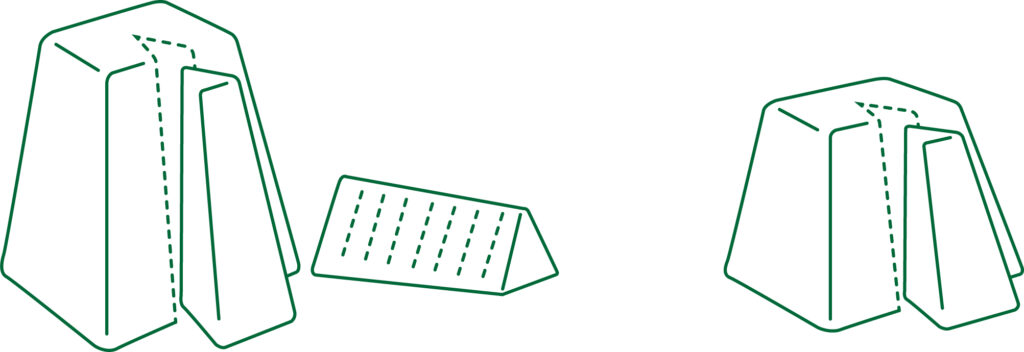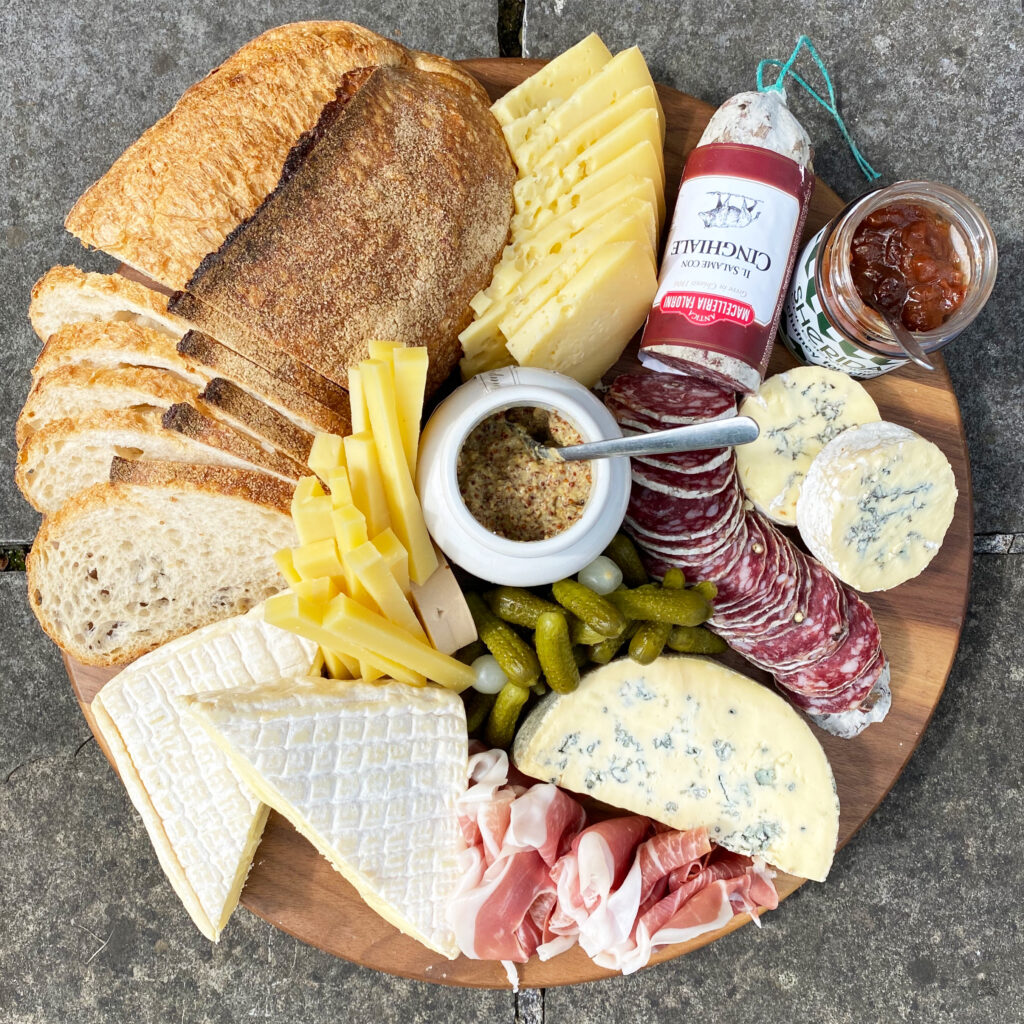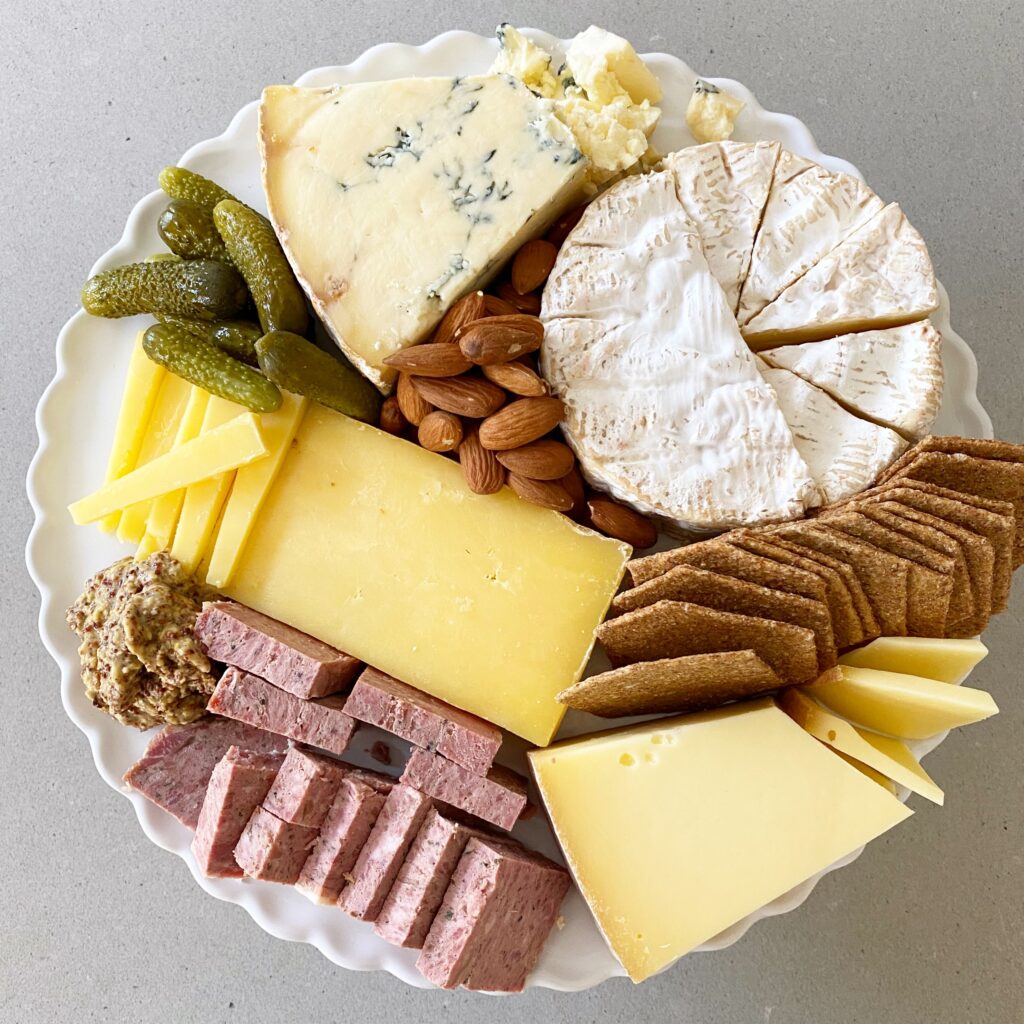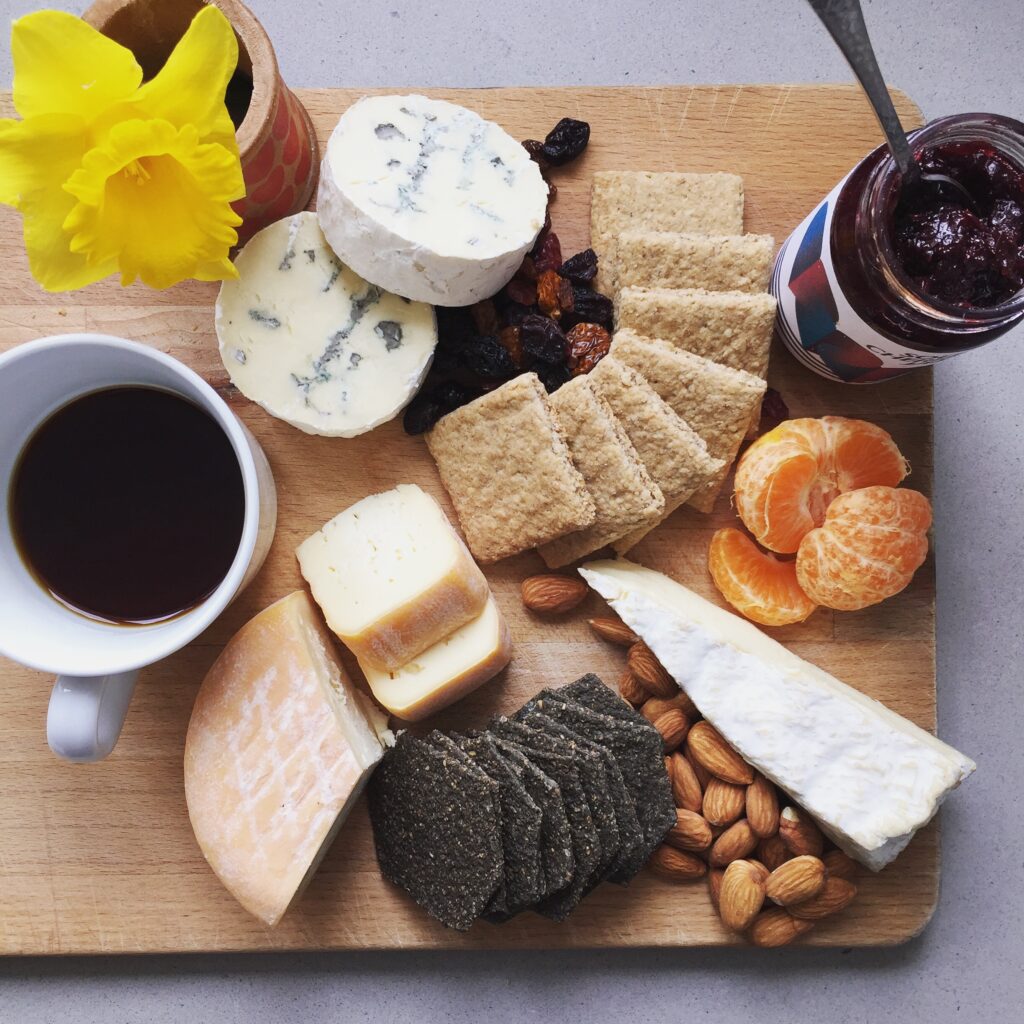Support
Cheese Care
Cheese should be stored in a cool place: Harder cheeses at about 10 °C (your porch, if you have one, can be a great place during the winter months). For softer and blue cheeses 4°C is ideal. A good compromise is to store all your cheese in the vegetable compartment of your fridge, usually at around 4.5°C. It can be stored in its original wrapper. If you are removing portions, you can re-wrap in greaseproof, cheese paper or our Sheridans Millbee Wax Wraps. Clingfilm is fine for harder cheeses but can impart a plastic flavour over time.
Best before and use by dates should be respected, although it is very difficult for the cheesemaker to determine the exact date when a cheese will no longer be of the best quality. Taste and smell are always your best tools to ascertain whether a cheese is good to eat! As mentioned above yeasts and moulds are to be expected, so you can scrape any that form on the cheese off, if you wish……
Frequently, cheeses that start to grow mould while aging, in storage, or during transit can be salvaged and are safe to consume. In the case of blue/white mould that has begun to form, it can be scraped off with regular dinner knife or back of chef knife, and bloomy rind cheeses often begin to re-rind themselves on the cut surface which can just be cut off or eaten.
Spoiled cheese has some key indicators – if you get an ammonia/sour smell or taste then it goes in the bin.
Fresh, high moisture, young cheeses (think mozzarella/ricotta/mascarpone/cream cheese) that have mould growing should be discarded immediately.
Moulds that show up with black or reddish hue should be discarded.
Our primary aim is to provide delicious, quality, safe cheeses to our Sheridans customers however cheese is a living thing with an agenda of its own. If you believe your cheese (or other food item) has spoiled, please contact us immediate at online@sheridanscheesemongers.com for a replacement or refund.
Cheeses like cheddars that have more open texture pastes where the curd is not heavily compacted during the cheesemaking process can have occasional blue veining. Though this blueing is caused by unintentional rouge pencillium genus mould that has found its way into the cheese, it is often sought after for its contributing flavour.
Cheese should be unpacked and stored in a cool place, ideally around 5 degrees. Take out about an hour before serving, and allow to come to room temperature. Leaving cheese come up to room temperature (“to chambre”) allows it to develop a fuller, more aromatic flavour. Beware temperatures that are too warm (hot kitchen) and try and let the cheese come up to temperature in a relatively cool place like a cool pantry. Harder cheeses can need a little more time than softer ones.
Cheese Club
We deliver cheese club on the second Thursday of each month.
Each month Kevin Sheridan specially selects four to five cheeses to be included in the month’s Cheese Club. We provide around 200g of each cheese and always ensure at least some of them will last well. Kevin selects the cheeses according to a particular theme based on style, season or production area. For most months this involves bringing in some cheeses which have never been available in Ireland before, often rare or unusual. Kevin writes the Cheese Club notes which accompanies the cheeses explaining the theme along with detailed information about each cheese.
Cheese General Information
Know anyone who doesn't eat cheese due to lactose intolerance? Or perhaps you yourself have to turn down cheese because of a lactose allergy? What you probably don't know is that lactose intolerance should NOT affect cheese consumption. You may actually be suffering from something else!
Surprisingly, most cheeses don't contain lactose! What's happening when milk turns to cheese is a souring process called acidification, whereby the lactose in milk is converted into lactic acid. This is the magical fermentation process in cheesemaking, when a sugar — in this case, milk sugar, or lactose — is converted into something else — in this case, lactic acid, which happens to be an entirely different entity from lactose. By the time a cheese is made, most or all of the lactose present in the milk no longer remains.
The longer that milk is left to sour, the greater the opportunity for all of that lactose to dissipate into lactic acid. A longer period of acidification allows the protein chains to form even stronger bonds, which will result in a firmer curd — and ultimately a firmer cheese that can age longer. Therefore, it's the harder, drier, and more aged cheeses that will be the safest to eat if you're lactose intolerant. Fresher cheeses that are higher in moisture may retain a small amount of lactose because the milk has not been left to ferment completely. People who are lactose intolerant may have issues with fresher styles.
If you don't really know if you're lactose intolerant, try eating a hard cheese like parmesan, which has virtually no residual lactose. No good? What you probably have then is a MILK allergy, in which case all types of cheese will give you problems. But if harder, (virtually lactose-free) cheeses are okay but you still have issues with fresher, high-moisture cheeses plus yogurt, ice cream, and other dairy products, then it's probably safe to say that you are indeed lactose intolerant.
Lactose intolerance and dairy allergies are two different topics. The former consists of intolerance for milk sugars (lactose), while the latter implies a negative reaction to the proteins in milk and milk products. Unfortunately, those with dairy allergies are SOL, but there is hope for people suffering from lactose intolerance. In fact, almost all of us have a little trouble with lactose.
If you are lactose intolerant you can eat some cheeses, but beware. Not all cheeses are created equal and some do retain much of their original lactose. If you are to embark on a new painless cheese lifestyle, you’ll have to follow a couple guidelines.
The Rules
Experiment on yourself!
But first, buy some Lactaid, just to be safe.
Avoid fresh cheeses
Most young cheeses, like mozzarella, have a high moisture content and retain a lot of whey, and therefore lactose. However, there are a few fresh cheeses, such as quark, that are made with cultured milk, which you might be able to stomach.
Start with older cheeses
Start with one ounce of a semi-firm cheese that’s at least 60 days old, such as young gouda, and see how you feel. If you feel discomfort, try an even older cheese. If all goes well, maybe go a little younger. Ask your local cheesemonger for help on gauging cheese ages.
Eat raw cheeses
Unpasteurized cheeses have more digestive enzymes than pasteurized, which of course means easier digestion
Try avoiding cow milk cheese
Some people have issues digesting cow milk, because the fat globules are harder to break down than the milk of other livestock animals. Try older sheep and goat milk cheese instead.
You can eat some cheeses when you're pregnant, and cheese is great source of calcium. However, some cheeses are not safe to eat. Unsafe cheeses are more likely to grow bacteria such as listeria, which can harm your unborn baby. Please always consult your doctor for advice on dietary practice during pregnancy.
These cheeses are not safe for you while you're pregnant:
· Soft, mould-ripened cheeses, such as brie, camembert and chevre (a type of goat's cheese).
· Blue-veined cheeses, such as danish blue and stilton.
Even if these cheeses are pasteurised, they still aren't safe to eat. That's because they are more moist and less acidic than other cheeses. It's this moistness and acidity which provide the perfect environment for listeria bacteria to grow. If you become infected with listeria, you can get an illness called listeriosis. This causes flu-like symptoms that develop several weeks after you've been exposed to the bacteria. Even though listeriosis a fairly mild illness for you, it can cause serious health problems for your baby. It can even lead to miscarriage, or the loss of a baby at birth. However, you can eat these cheeses if you cook them thoroughly, as this will kill any listeria. Just make sure you've cooked the cheese until it's piping hot all the way through, and it hasn't just melted. All hard cheeses are generally considered safe to eat, even if they are made with unpasteurised milk. There is only a very small amount of listeria bacteria in hard cheeses so they are not considered a risk during pregnancy.
Some safe cheeses in pregnancy include:
· Hard cheeses: smoked versions, cheddar, edam, emmental, English goat's cheddar, feta, gouda, gruyere, halloumi, manchego, paneer, parmesan, pecorino (hard), provolone
· Soft, processed cheeses: garlic and herb roulade, cottage cheese, cream cheese, feta, goat's cheese without a white rind, mascarpone,
mozzarella, processed cheese (such as cheese spread and cheese segments), quark, ricotta.
· Yoghurts, probiotic drinks, fromage frais, soured cream and creme fraiche are all safe to eat. These include any variety, including natural, flavoured and live versions.
Unsafe cheeses in pregnancy
· Mould-ripened soft cheeses: brie, blue brie, cambozola, camembert, chaumes, chevre (goat's cheese with a white rind), pont l'eveque, taleggio, vacherin-fribourgeois.
· Blue-veined cheeses: bergader, bleu d'auvergne, blue wensleydale, shropshire blue, danish blue, dolcelatte, gorgonzola, roncal, roquefort, stilton, tomme.
· Soft, unpasteurised cheese, including goat's and sheep's cheeses: chabichou, pyramide, torta del cesar
You may be familiar with the term vegetarian rennet, which is often displayed on the label of cheeses. This almost always refers to amicrobial rennet substitute. Microbial rennet is produced by a fungi grown and fermented in a lab setting. This type of rennet works quite well and is cheaper than traditional rennet but can produce a bitter taste in mature cheeses. However this pure microbial rennet has almost entirely been replaced by a more modern version, FPC – Fermentation Produced Chymosin rennet. This version of microbial rennet is made by taking the enzyme-producing gene out of the mammal’s cell’s DNA string and introducing it into a host fungi’s DNA string. This enables the fungi to produce the chymosin enzyme. This fungi can then be cultivated in a lab and fermented, ready to be used as rennet. This genetically modified rennet does not give the bitter flavour in mature cheeses and it is even cheaper to produce. The use of vegetarian rennet is not always advertised on the labels of cheese. The ingredients often just say rennet but, because of its cost effectiveness, genetically modified rennet is used in the production of almost all industrial cheeses. It is important to distinguish this genetically modified organism from genetically engineered foods. When the DNA from the animal is inserted into the fungi, it is not altered, whereas in genetically engineered products the DNA is altered to change its function, altering completely the nature of the gene. There is a third version of vegetarian rennet called thistle rennet. This is the only true vegetable rennet produced from the cardoon thistle (Cynara cardunculus), a species of artichoke. This plant contains an enzyme called cardosin which acts to coagulate the milk in a similar way to the chymosin enzyme. Coagulation takes longer and works better in milk with high levels of protein and fat, so sheep’s milk is perfect. It is most commonly used in Portuguese sheep’s milk cheeses but has also been used for centuries in areas of Spain, Italy and France. Jewish communities were using it to make kosher cheese before the invention of modern rennet substitutes. It gives a particular citrusy and slightly bitter flavour and a more fudgy texture. Some of the most interesting and delicious cheeses are made using this gift of nature
Rennet is made of enzymes chymosin and pepsin found in the stomach lining of ruminant mammals. It is a natural coagulant that helps form the curds in the cheesemaking process and ensures the coagulation happens without the cheese going sour. Rennet is only derived from animals that have previously been slaughtered and never solely for this purpose.
In most cases, yes! Unless it’s covered in wax or cloth, eating the rind is a preferential decision. Technically rinds on comte and rinded blues are totally edible but they can impart a bitter flavour. Cheese is a natural product, and from time to time you can expect some blooms and moulds to develop on the outside, this is perfectly natural. Some people prefer not to eat the rind at all. As a rule of thumb – on hard cheeses the rind is best removed, on softer cheeses it is by most considered to be an integral part of the cheese, but it should always be a case of personal preference (if you enjoy it – eat it, if you don’t, then don’t!) the cheese (paste) just under the rind is usually the tastiest!
For a cheeseboard allow around 75g-100g approximately of cheese in total for each guest. Therefore if you are serving 10 people and have 4 cheeses, you would serve around 1kg in total, so about of 250g of each cheese.
The amount of cheese required will also depend on whether the cheeses are to be served after dinner, at a tasting or as finger food etc. The manner in which the cheese is to be served – whether as individual cheese plates, buffet style, or as cheeseboards – will also affect the quantities required.
Leave the cheese in the fridge for as long as possible before going on display.
Cheese should be unpacked and stored in a cool place, ideally around 5 degrees. Take out about an hour before serving, and allow to come to room temperature. Leaving cheese come up to room temperature (“to chambre”) allows it to develop a fuller, more aromatic flavour. Beware temperatures that are too warm (hot kitchen) and try and let the cheese come up to temperature in a relatively cool place like a cool pantry. Harder cheeses can need a little more time than softer ones.
Cheesecakes
We deliver Tuesday – Thursday and recommend delivery at a minimum of two days before the event for peace of mind. For example, if your wedding is on a Saturday, we deliver to the venue on the Thursday. If you need the cheesecake the day before or day of the event, collection from the Dublin, Meath or Galway shop is available. We do not deliver between Christmas and New Year but collection from our Meath/Galway/Dublin shop is possible. For the Dublin area, we can deliver on the wedding day by taxi – please call for a quote.
Ideally 1-2 months before your date but we can also accommodate short notice. If you have a short deadline, give us a call.
Meath: 046 924 5799
Dublin: 01 679 3143
Galway: 091 564829
We ship to anywhere on the Island of Ireland. We use an overnight courier for delivery in Ireland. Please ensure that the delivery address you give is one where there is someone to accept day-time deliveries.
The cheese arrives packed for shipping and needs to be assembled by yourself, your caterer or a friend/family member. We recommend getting offcuts or additional flowers from your florist for the event to decorate your cake with. Alternatively, decorating your cake with fresh fruit and other cheese accompaniments can work too!
Whatever you like! That’s half the fun. We offer a range of crackers and accompaniments from single jars to catering packages depending on the size of your party. Additionally, we’ve selected cheese accompaniments that we love and you can check out here (link to accompaniment product)
We recommend visiting one of our stores closest to you or having a cheese tasting selection shipped to your door. Each tasting selection corresponds with the appropriate cake and can be ordered here (link to tasting products).
Cheesecakes are usually decorated and put on display similar to a regular cake. Once you are ready to serve, you, your helpers or your venue can disassemble and either serve as large hunks of cheese to be dug into by your guests or they can be taken to a cutting board to be sliced up and plated individually or replated onto a large serving platter.
Custom cheesecakes can be ordered at your local Sheridans or by emailing online@sheridanscheesemogners.com
Sheridans Cheesecakes are made from full wheels of our favourite cheeses. We have carefully selected cheeses that people love and also have good stacking capabilities. There are large cakes and there are small cakes and everything in between to suit your party needs whether they be for 2 people or 200+
How to Cut & Serve Cheese
Cheddar
Cheddar can be a great versatile cutting cheese with a few options. Depending on what you like, or what your cheese board needs, it can be broken into crumbles or slices (triangular or rectilinear) If you have a drier, more flakey cheddar, you're probably best off with crumbles. Younger or less dry cheddars lend themselves to slices quite easily.

Blues
Frequently with more water content than others, these are easiest served in large triangular pieces cut radially from the centre outwards. If you want or need to serve in smaller pieces we highly recommend chunks or crumbles. Some firmer blues like Boyne valley lend themselves to triangular slices.

Bries and soft (but not runny) cheeses
Bries are traditionally cut with thin long knives but you can certainly use a wire or your kitchen knife. Cutting in a radial fashion from the center with a sharp knife or wire should be quite easy. Brie de Meaux or other large format soft cheeses can have narrow triangular slabs cut that are then halved or quartered across the cut piece.

Super soft, oozy cheeses
You cant contain greatness! IF you’re dealing with a super ripe, oozy cheese that you want to feature on your cheeseboard we recommend placing within a bowl or rimmed plate that will help contain the cheese and create a good place to scrape up the cheese with crusty bread without making a huge mess. You can always use a shallow spoon for service as a knife doesn’t hold too much.

Goudas and extra Hard cheeses
Hard cheeses like Manchego we like to cut into small triangles after removing the rind and then cutting across from tip to rind, forming thin triangle slices.
For extra hard cheeses like mature goudas, parmigiano Reggiano or pecorino sardos we like to either crumble the cheese with small knife by cutting downward into the cheese and twisting. Alternatively, we like to use a vegetable peeler or graters to shave small curls or shards off from these harders cheeses – just watch your fingers!

Pyramid shaped cheeses
These beautiful cheeses always make a great impression on any cheeseboard. To cut, slice down form the top through to the base on perpendicular sides. You’ll be able to extract a corner slice which can then be laid on it’s side and sliced lengthwise for smaller portions.

Log cheeses
Small logs can be slices with a sharp knife or wire harp to form disk shaped portions. If it’s a larger log the disks can then be sliced down further depending portion size desired.

Rectangular Slabs & Round Slabs
We like to keep rectangular slab cheeses in a rectilinear fashion by slicing into narrow batons, squares, or smaller rectangles. For large round slab cheeses like fourme d'ambert or cashel, we like to cut in a radial fashion.

In our opinion, a great cheeseboard is at the heart of every great party. Whether you are entertaining for 2 or 200, there are loads of options to create the perfect cheese and charcuterie platters on any budget.
If you are entertaining groups of 6+ we recommend cutting cheeses for easy access as opposed to big chunks for cheese. BUT! You know your guests best, if they are happy to dig into large pieces of cheeses, we say let them work away!
For more info on how to cut your cheeses, see our 'how to cut cheese' section for the different types of cuts based on the cheese type you have.
We always like accompaniments with our cheeseboards and we include our suggested accompaniments with every cheese featured on the Sheridans website. Broadly speaking…. Chutney is great for adding a bit of acidity to contrast with rich flavour of the cheeses. Something sweet like honey or jam is a nice addition to cheeses like bries, goats cheeses, or washed rind cheeses. More bright or sharp flavour items like cornichons or fresh fruits and vegetables are nice for palette cleansers.
Charcuterie is a nice addition that adds another depth of flavour and attractive feature to any cheeseboard.
Deli items like olives, cornichons, roasted red peppers add a lovely bit of color, texture and flavour to your boards.
Crackers are always a welcome vehicle in creating your perfect bite or you can always pick up fresh crusty baguette from your local bakery.




In most cases, yes! Unless it’s covered in wax or cloth, eating the rind is a preferential decision. Technically rinds on comte and rinded blues are totally edible but they can impart a bitter flavour. Cheese is a natural product, and from time to time you can expect some blooms and moulds to develop on the outside, this is perfectly natural. Some people prefer not to eat the rind at all. As a rule of thumb – on hard cheeses the rind is best removed, on softer cheeses it is by most considered to be an integral part of the cheese, but it should always be a case of personal preference (if you enjoy it – eat it, if you don’t, then don’t!) the cheese (paste) just under the rind is usually the tastiest!
When serving, remove only the amount you think you will use for the occasion from the cooler storage place. Take out about an hour before serving, and allow to come to room temperature. Leaving cheese come up to room temperature (“to chambre”) allows it to develop a fuller, more aromatic flavour. Having said that many modern houses are too warm for ‘chambre-ing’ cheeses, and cheese can become overly pungent, runny and ‘sweaty’ if kept at too warm a temperature. Try and let the cheese come up to temperature in a relatively cool place, and bear in mind that room temperature is not a hot kitchen – more a cool pantry. Harder cheeses can need a little more time than softer ones.
For a cheeseboard allow around 75g-100g approximately of cheese in total for each guest. Therefore if you are serving 10 people and have 4 cheeses, you would serve around 1kg in total, so about of 250g of each cheese.
The amount of cheese required will also depend on whether the cheeses are to be served after dinner, at a tasting or as finger food etc. The manner in which the cheese is to be served – whether as individual cheese plates, buffet style, or as cheeseboards – will also affect the quantities required.
Leave the cheese in the fridge for as long as possible before going on display.
Shipping & Returns
Yes! Please contact online@sheridanscheesemongers.com for all your corporate gifting needs. We ship anywhere in Ireland and can provide complementary gift notes included.
We ship with UPS. Once your order is placed, your order tracking number will be emailed to you from UPS.
Delivery to Republic of Ireland & Northern Ireland : €10
Delivery to EU: Flat rate €50
All Sheridan's cheeses and specialty foods are packing in thermal recyclable paper and cardboard packaging. Icepacks and glass wrap are used where appropriate.
Find us at the following locations in the Republic of Ireland
Orders placed before 11:00 am can be shipped the same day for next day delivery Monday-Thursday.
Choose your own Delivery Date! Check out our Delivery Date Calendar to select the delivery date that works for you, this is on the check out page!
If you require a delivery for a specific date - during busier periods such as Christmas we recommend picking an earlier delivery date to make sure your order arrives in plenty of time.
Delivery Times (or delivery windows) are scheduled at discretion and route planning of our courier and cannot be scheduled through Sheridans.
We ship across the Republic Of Ireland and the EU
We can deliver:
- Ireland: Tuesday – Friday
- EU: Wednesday – Friday
Delivery to Rep of Ireland & N. Ireland: Flat rate €10 - per address
Delivery to EU: Flat rate €50
Orders for England / Scotland / Wales are temporarily suspended due to Brexit





